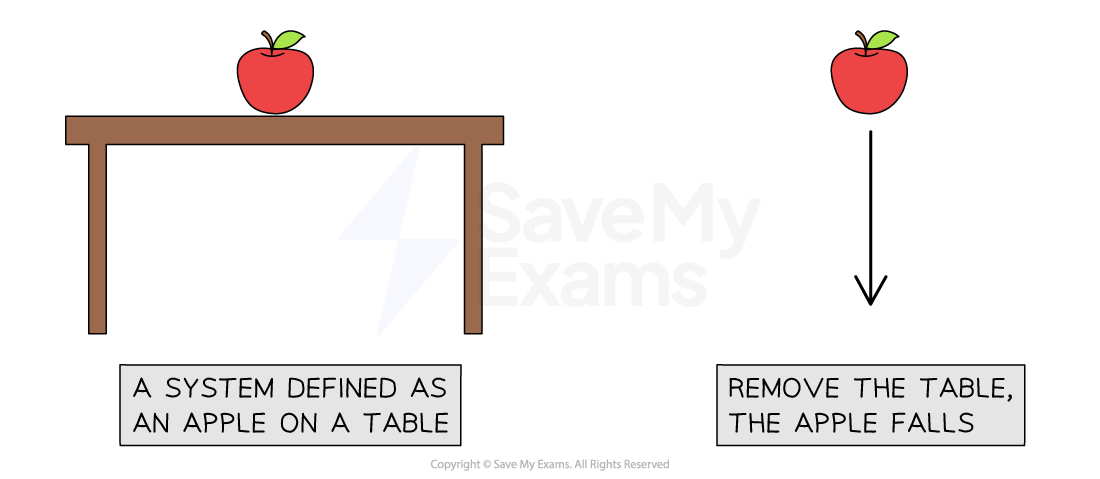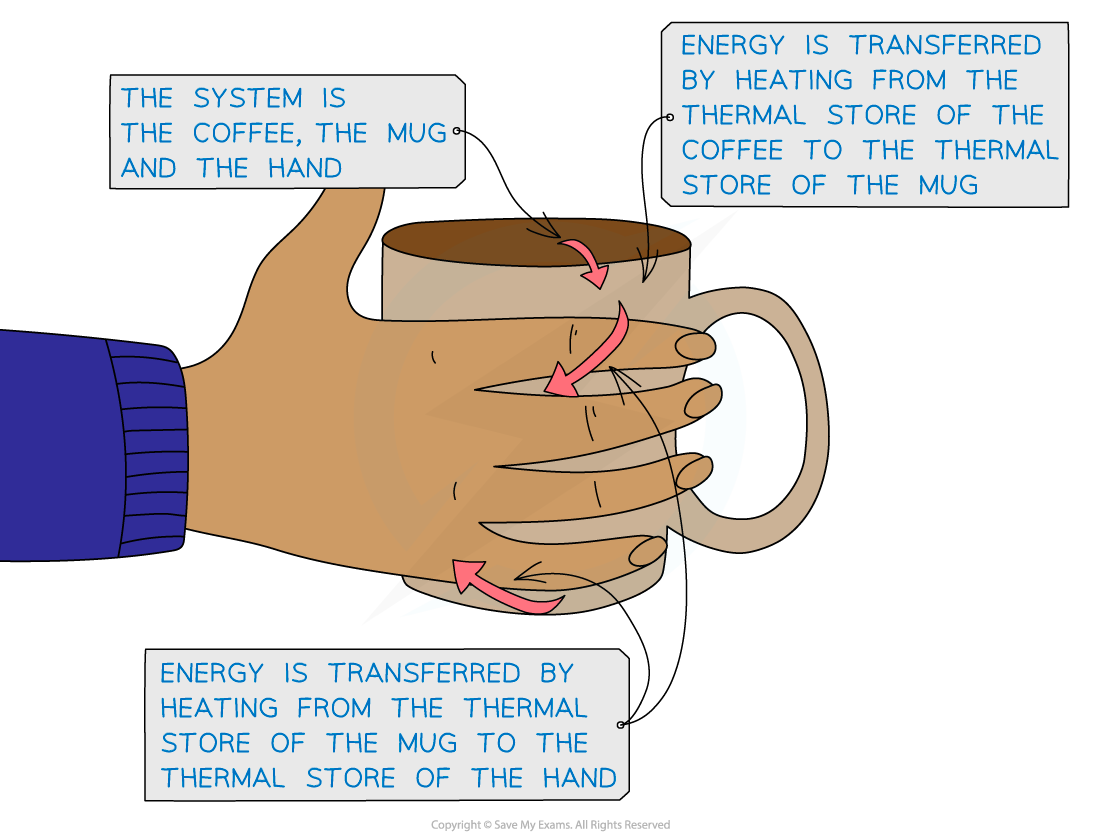Energy Stores & Transfers (Cambridge (CIE) O Level Physics) : Revision Note
Did this video help you?
Energy Stores
Energy is a property that must be transferred to an object to perform work on or heat up that object
Energy is measured in units of joules (J)
Energy will often be described as part of an energy system
In physics, a system is defined as:
An object or group of objects
Defining the system, in physics, is a way of narrowing the parameters to focus only on what is relevant to the situation being observed
A system could be as large as the whole Universe, or as small as an apple sitting on a table
When a system is in equilibrium, nothing changes, and so nothing happens
When there is a change to a system, energy is transferred
If an apple sits on a table, and that table is suddenly removed, the apple will fall
As the apple falls, energy is transferred
Example of Energy Transfer

Energy is transferred when the apple is falling - the system is changing
Energy is stored in objects in different energy stores
Descriptions of Energy Stores
Energy Store | Description |
|---|---|
Kinetic | Moving objects have energy in their kinetic store |
Gravitational | Objects gain energy in their gravitational potential store when they are lifted through a gravitational field |
Elastic | Objects have energy in their elastic potential store if they are stretched, squashed or bent |
Magnetic | Magnetic materials interacting with each other have energy in their magnetic store |
Electrostatic | Objects with charge (like electrons and protons) interacting with one another have energy in their electrostatic store |
Chemical | Chemical reactions transfer energy into or away from a substance's chemical store |
Nuclear | Atomic nuclei release energy from their nuclear store during nuclear reactions |
Thermal | All objects have energy in their thermal store, the hotter the object, the more energy it has in this store |
Did this video help you?
Energy Transfers
Energy is transferred between stores through different energy transfer pathways
The energy transfer pathways are:
Mechanical
Electrical
Heating
Radiation
These are described in the table below:
Energy Transfer Pathways Table
Transfer Pathway | Description |
|---|---|
Mechanical working | When a force acts on an object (e.g. pulling, pushing, stretching, squashing) |
Electrical working | A charge moving through a potential difference (e.g. current) |
Heating (by particles) | Energy is transferred from a hotter object to a colder one (e.g. conduction) |
(Heating by) radiation | Energy transferred by electromagnetic waves (e.g. visible light) |
An example of an energy transfer by heating is a hot coffee heating up cold hands
Energy Transfers Scenario

Energy is transferred by heating from the hot coffee to the mug, to the cold hands
Worked Example
Describe the energy transfers in the following scenarios:
a) A battery powering a torch
b) A falling object
Answer:
a)
Step 1: Determine the store that energy is being transferred away from, within the parameters described by the defined system
For a battery powering a torch
The system is defined as the energy transfer from the battery to the torch, so this is the transfer to focus on
Therefore, the energy began in the chemical store of the cells of the battery
Step 2: Determine the store that energy is transferred to, within the parameters described by the defined system
When the circuit is closed, the bulb lights up
Therefore, energy is transferred to the thermal store of the bulb
Energy is then transferred from the bulb to the surroundings, but this is not described in the parameters of the system
Step 3: Determine the transfer pathway
Energy is transferred by the flow of charge around the circuit
Therefore, the transfer pathway is electrical
Energy is transferred electrically from the chemical store of the battery to the thermal store of the bulb
b)
Step 1: Determine the store that energy is being transferred away from, within the parameters described by the defined system
For a falling object
In order to fall, the object must have been raised to a height
Therefore, it began with energy in its gravitational potential store
Step 2: Determine the store that energy is transferred to, within the parameters described by the defined system
As the object falls, it is moving
Therefore, energy is being transferred to its kinetic store
Step 3: Determine the transfer pathway
For an object to fall, a resultant force must be acting on it, and that force is weight, and it acts over a distance (the height of the fall)
Therefore, the transfer pathway is mechanical
Energy is transferred from the gravitational store to the kinetic store of the object via a mechanical transfer pathway
Examiner Tips and Tricks
Don't worry too much about the parameters of the system. They are there to help you keep your answers concise so you don't end up wasting time in your exam.
If you follow any process back far enough, you would get many energy transfers taking place. For example, an electric kettle heating water. The relevant energy transfer is from the thermal store of the kettle to the thermal store of the water, with some energy dissipated to the surroundings. But you could take it all the way back to how the electricity was generated in the first place. This is beyond the scope of the question. Defining the system gives you a starting point and a stopping point for the energy transfers you need to consider.

You've read 0 of your 5 free revision notes this week
Sign up now. It’s free!
Did this page help you?
